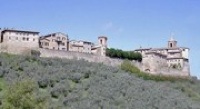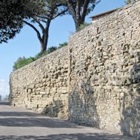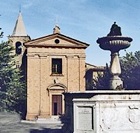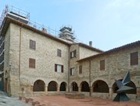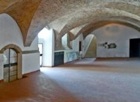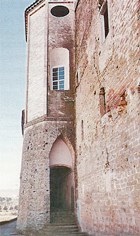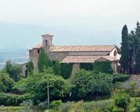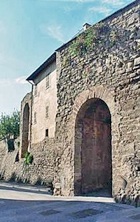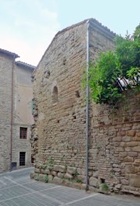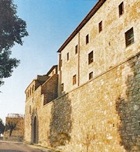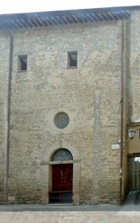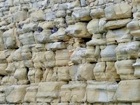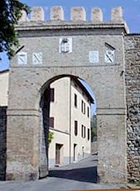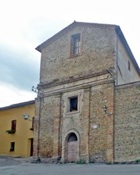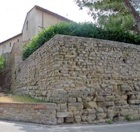The first walls of Bettona (4th century BC) seem to have been built under Etruscan influence, using squared blocks of local sandstone. They might have been needed to protect the small settlement from the nearby Etruscan city of Perusia (Perugia), or they might alternatively have formed part of an outer defensive ring that protected that city. The circuit ran in an ellipse of about 1 km in circumference.
Comparisons with the city walls of Todi and Assisi, and particularly with those of Perugia, suggest that they were built no earlier than the 3rd century BC. The Perugians destroyed the walls in 1352, and Cardinal
Gil Albornoz rebuilt them in 1367, using the original foundations for much of the circuit and reusing many of the original stones.
The walk begins from Piazza Garibaldi.
Turn right in front of the facade of church of San Crispolto (illustrated above), towards the cloister to the right of it.
The door at the extreme left of the photograph above of the cloister leads along its left side and into this room of the ex-convent, which was adapted for residential use in 1978. The medieval wall seems to have deviated from the ancient line in this area, and traces of the original wall were found under the convent at this time.
The door at the extreme left of the photograph of that room leads to a passage that runs along the right side of the church and then under its apse to Porta San Crispolto.
Walk along the right side of San Crisploto and into a room ahead that was part of the convent. The second door from the right ahead leads to a passage that in turn leads to the Porta San Crispolto, which is embedded in the apse of the church. The ex-convent was adapted for residential use in 1978, and notable remains of the original city wall were discovered at this time.
Continue to Porta Romana (le Quattro Porte), with Porta San Pietro beyond.
The latter [the earlier of the two?] was originally a drawbridge.
It was named for the ex-church of San Pietro, which you can see if you take a short detour through Porta Romana: it is on the far side of the first junction on the right. This was apparently one of the first churches to be built in Bettona: it stands on Etruscan foundations that could have been part of a double gate or perhaps belonged to and ancient building.
Return through Porta Romana and continue past the Monastero di San Giacomo (above the walls) to Porta Primo Maggio. This gate is also known as Porta Pustierle, because it is only for pedestrian use.
Take a short detour through Porta Primo Maggio to see the ex-church of San Giacomo on the right. Then return through the gate and continue the circuit.
The ancient stones here have a particular shape that gives them the nickname “culo delle monache” (backsides of the nuns).
Continue to Porta Vittorio Emanuele (ex- Porta Santa Caterina). [Arms of Cardinal Albornoz ?]
Continue to Piazza Garibaldi, where the walk ends.


